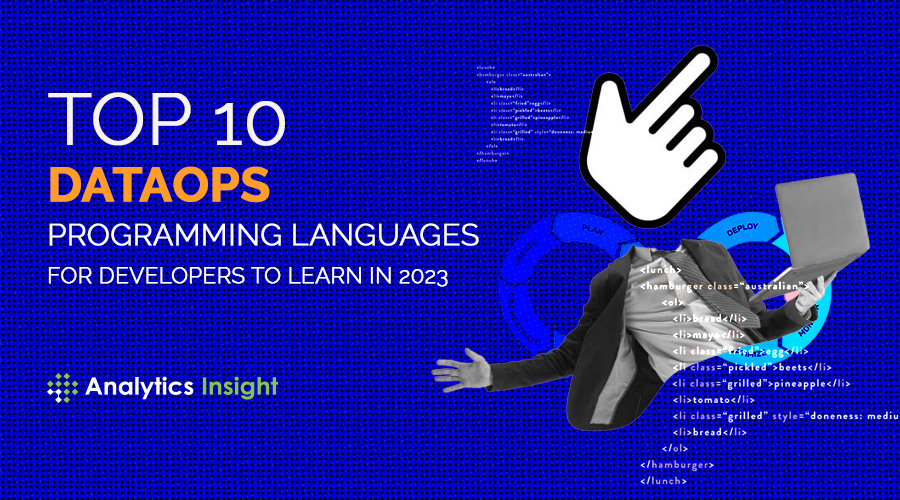[ad_1]
The article enlists the top 10 DataOps programming languages for developers to master in 2023
DataOps is a set of practices, processes, and technologies that combines an integrated and process-oriented perspective on data with automation and methods from agile software engineering to improve quality, speed, and collaboration and encourage a culture of continuous improvement in the area of data analytics. While DataOps began as a set of best practices, it has now matured to become a new and independent approach to data analytics. Therefore, learning DataOps programming languages is the top priority for data science students. Top DataOps programming languages allow you to quickly extract value from your data and help you create models that let you make predictions. However, it is important to know which DataOps programming languages are best for different tasks. To ensure that you can pick the appropriate tool for your job, this article will look at some of the most popular DataOps programming languages for 2023 and the choice will become easier when you are aware of your data science career path.
JavaScript
JavaScript is top in the list of dataOps programming languages that originated to develop web applications and websites. It has since become the most popular programming language for building client-side applications online. JavaScript is also famous for its versatility, and it is helpful for everything from simple animations to complex artificial intelligence applications.
PYTHON
Python is another programming language that provides the least code among all others. It is a general-purpose programming language that can get used to developing any software. Python is known for its simple syntax, easy readability, and code portability. It’s also open-source and runs on all major platforms, making it popular among developers. It is among the top programming languages for data science. With all these features and many others, Python is considered one of the top DataOps programming languages for development.
SQL (Structured Query Language)
SQL is one of the world’s most widely used programming languages. It is a programming language for interacting with databases and permits you to create queries to extract information from your data sets. SQL has its uses in almost every industry, so learning it in the early phase of your data science journey will be a good decision. SQL commands can get executed interactively from a terminal window or through embedded scripts in other software programs such as web browsers or word processors.
R
R is a statistical programming language commonly used for statistical analysis, data visualization, and other forms of data manipulation. R has become increasingly popular because it is very easy to use and flexibility to handle complex analyses on large datasets. Additionally, R language offers many packages for machine learning algorithms such as linear regression, k-nearest neighbor algorithm, random forest, neural networks, etc., making it a popular choice for many businesses looking to implement predictive analytics solutions into their business processes.
MATLAB
MATLAB is a must-have programming language for DataOps, particularly for working with matrixes. MATLAB is not an open-source language but is used extensively in academic courses because of its suitability for mathematical modeling and data acquisition. Though MATLAB lacks the volume of open-source community-driven support, its extensive adoption in academic courses has made it popular for data science. MATLAB programming language is good for DataOps tasks that involve linear algebraic computations, simulations, and matrix computations.
Julia
Julia is also an important programming language for DataOps that aims to be simple yet powerful, with a syntax similar to MATLAB or R. Julia, also has an interactive shell that offers users to test code quickly without having to write entire programs simultaneously. Moreover, it is fast and memory-efficient, making it well-suited for large-scale datasets. It makes coding very fast and more intuitive since it allows you to focus on the problem without worrying about type declarations.
Java
Java by Oracle is the best programming language available to learn. It is a general-purpose computer programming language that is concurrent, class-based, object-oriented, and specifically designed to have as few implementation dependencies as possible. Over the years, Java has adapted to the latest developments and technological advancements. It is intended to let application developers “write once, run anywhere” (WORA), meaning that compiled Java code can run on all platforms that support the Java virtual machine (JVM) or JavaScript engines.
GO
GO is a newcomer in the world of dataOps programming languages but its gaining popularity because of its simplicity. Golang developed at Google by a group of engineers who were done with the use of C++, is an open-source language based on C. GO has not been developed particularly for statistical computing but has achieved mainstream presence for DataOps programming because of its speed and familiarity.
Scala
Scala is the most popular language for AI and data science use cases. Because it is statically typed and object-oriented, Scala has often been considered a hybrid language used for dataOps and data science between object-oriented languages like Java and functional ones like Haskell or Lisp. Moreover, Scala has many features that make it an attractive choice for data scientists, including functional programming, concurrency, and high performance.
Statistical Analytical System (SAS)
This dataOps programming language is specially developed for business operations and complex arithmetic computerization. Many companies have adopted SAS to carry out their tasks. The drawback of SAS is that it requires a license to put it to use, unlike Python and Java. Like MATLAB, SAS also loses the crown to Python and R language regarding accessibility. For new consumers and companies, this provides a barrier to access, making them more likely to choose easily accessible languages like Java or C++.
Share This Article
Do the sharing thingy
[ad_2]
Source link
